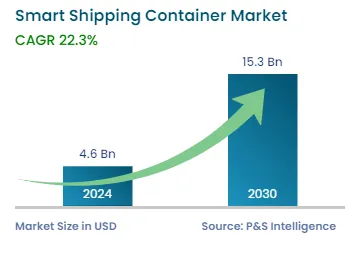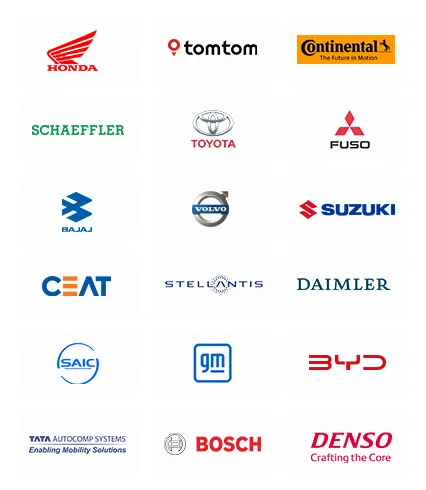Market Statistics
| Study Period | 2019 - 2030 |
| 2024 Market Size | USD 4.6 Billion |
| 2030 Forecast | USD 15.3 Billion |
| Growth Rate(CAGR) | 22.3% |
| Largest Region | Europe |
| Fastest Growing Region | Asia-Pacific |
| Nature of the Market | Consolidated |
Report Code: 12629
Get a Comprehensive Overview of the Smart Shipping Container Market Report Prepared by P&S Intelligence, Segmented by Offering (Hardware, Software, Services), Technology (GPS, Cellular, LoRa WAN, BLE), Vertical (Food & Beverage, Pharmaceutical, Oil & Gas, Chemical), and Geographic Regions. This Report Provides Insights from 2019 to 2030.
| Study Period | 2019 - 2030 |
| 2024 Market Size | USD 4.6 Billion |
| 2030 Forecast | USD 15.3 Billion |
| Growth Rate(CAGR) | 22.3% |
| Largest Region | Europe |
| Fastest Growing Region | Asia-Pacific |
| Nature of the Market | Consolidated |

Explore the market potential with our data-driven report
The global smart shipping container market size stood at USD 4.6 billion in 2024, and it is expected to grow at a CAGR of 22.3% between 2024 and 2030, to reach USD 15.3 billion by 2030.
The growth can be primarily ascribed to the regulation of temperature, improve security, and real-time GPS tracking, which these containers enable. The sensors integrated into gather and track data on the operating conditions inside continuously. Various metrics, such as temperature, humidity, door status, and location of the package, can be checked. The contents can also be inspected remotely through a smartphone, computer, or tablet. This technology is ideal for shipping containers that ferry perishable cargo, such as produce, food, and medical supplies.
Due to the rapid technological advancements in IoT, AI, communication, and big data analysis, the market is poised for further advance. With the development of smart sensors, IoT devices are processing and sharing data faster and more efficiently. In the same way, the implementation of AI has helped in the prediction of estimated times of delivery, incidents, and delays, through advanced data analysis. This will create significant opportunities and use cases for shipping lines, thus enabling market expansion.
IoT platforms are being employed in hazardous locations, with the advancing technology. Due to the adoption of Industry 4.0 and other advanced manufacturing practices, most of the industrial organizations, as well as logistics service providers, are adopting IoT. This technology helps these companies in improving supply chain planning, enhancing transport conditions and product safety, and achieving reliable vehicle tracking. IoT devices are essentially used in containers to improve connectivity.
Smart containers use different technologies to communicate information captured via a wide range of sensors about their current status, such as door open/close status, GPS position, atmospheric conditions, movements, and vibrations and shocks. They are also able to remotely change their parameter settings anywhere, anytime, which includes adjusting temperature and initiating remote defrosting. It has been proven that IoT technologies offer a huge potential for businesses to mitigate their risks and increase their efficiency, which is why smart assets will become a standard in the shipping industry.
The hardware category holds the largest share, around 50%, and it is expected to witness the highest CAGR over the forecast period, owing to the extensive use of different components for monitoring and tracking applications. A large number of sensors are required for efficaciously monitoring the condition of the package being transported on a ship, flat railway wagon, or semi-trailer truck.
These components essentially provide detailed information on the humidity, temperature, and pressure inside and the movement of the package, to help shippers save money during their transportation. They also react to the changes occurring every minute in relation to the interior environment and respond immediately to it, relaying the information to a central monitoring facility located remotely. Thus, the remote diagnosis enabled by these components helps pinpoint the exact location of the cargo and saves significant time for crew members in fixing the problem.
This approach of remote condition monitoring ultimately helps reduce the damages incurred due to the loss or destruction of the goods. It also reduces the requirement for regular in-person checkups, which, in turn, saves time and aids in offering more convenience to the inspection crew.
Essentially, these components ensure the accuracy and reliability of shipment tracking with real-time information on their whereabouts and condition. Among all the hardware components, sensors hold the largest share because they are the most-used electronic components in smart containers.
Software demand is also growing significantly, as it acts as the interface between the location-based data and central control room, which can gather the required information for analysis. Hence, the rising need of transporters for insights into the package location and condition is propelling the demand for software that can offer enhanced analytics support.
GPS dominates the market because of its role in monitoring and tracking the movement of the package. The tracking of live data by modern GPS and cellular modem technology is of great help to the control centers involved in improving transportation management.
Furthermore, the rapid adoption of the Bluetooth Low Energy (BLE) technology is due to the increasing acceptance of IoT devices, which require an efficient means of communication. It is predicted that most containers will be equipped with IoT in the coming years since the integration of such technology is necessary for connectivity and communication.
The long-range wide area network (LoRa WAN) category is expected to grow at the highest rate, attributed to the advantage of LoRa WAN over other technologies, such as Wi-Fi and BLE. LoRa WAN offers long-range communication due to its high bandwidth. Moreover, it improves the performance of containers by enabling data sharing and delivering accurate information about the location.

The food & beverage vertical is expected to grow at the highest CAGR, more than 20%, ascribed to the increasing demand for perishable and packaged food. The focus of individuals is shifting from home-made to ready-to-eat food, which is driving the demand for smart marine transportation solutions for eatables.
It is understood that due to the logistical challenges and the varying climatic conditions in places where cargo is shipped, the food & beverage sector suffers a lot. Due to this, large quantities of food & beverages rot, thus resulting in heavy revenue losses to the industry. The use of smart marine transportation solutions enables food & beverage companies to reduce this risk via remotely changing the climatic conditions inside the container.
The pharmaceutical industry is also growing in the market as it is highly sensitive to time and quality assurances. Pharma products require appropriate storage and transportation conditions, especially with regard to temperature, owing to the stringent government regulations on quality and safety they must adhere to. The increasing demand for vaccines, drugs, and other medical supplies is, thus, boosting the market advance. Drug supply chains are exceptionally demanding, as transporters are expected to maintain cold-chain practices, as well as avoiding robberies during transportation.
Additionally, it is expected from the industry that it delivers critical products to customers at a competitive operational cost and in a secure manner. Smart containers have arisen as the most-reliable and -efficient solution for the delivery of delicate drugs. The pharmaceutical industry also benefits from them with the improved location tracking, humidity and pressure monitoring, near-real-time temperature maintenance, and heightened security, which ultimately aids in better adherence to government regulations.
Containers also carry donated organs and, therefore, require to be sealed tightly. Additionally, appropriate temperature should be maintained, and the entire thing must be kept in a safe location on the ship, to avoid the harm from jerking and unintentional falling.
Drive strategic growth with comprehensive market analysis
Europe has the leading position in the smart shipping containers market, with around 40% share in 2022. This is attributed to the presence of various key players offering hardware integrated with IoT sensors and advanced software for efficient data analytics.
In Europe, Germany holds the leading position, and it will grow with a CAGR of 18%, attributed to the fast adoption of advanced technologies, including artificial intelligence, machine learning, and IoT.
Moreover, the existence of various shipping companies in the region boosts the demand for smart shipping solutions. Moreover, in November 2022, the European Community Shipowners’ Associations (ECSA) announced that at least 20 million ETS allowances, which equal EUR 1.5 billion as per the current ETS carbon price, will be earmarked to maritime projects under the Innovation Fund.
Furthermore, the existence of highly industrialized economies, such as Germany, the U.K., France, Italy, and Belgium, boosts the solution demand. The government is also implementing initiatives to facilitate the growth of industries. For instance, according to the EU, 64% of the R&D expenditure by the private sector and 49% of the expenditure on innovation in Europe are accounted for by the manufacturing industry. As a result, shippers are using cutting-edge technologies, such as IoT, 3D printing, robotics, high-performance modeling and computing, and artificial intelligence.

Based on Offering
Based on Technology
Based on Vertical
Geographical Analysis
The market for smart containers will value USD 15.3 billion in 2030.
GPS tracking is the most popular in the smart container industry.
The market for smart containers is growing with the booming trade of perishable cargo.
Food & beverage and pharmaceuticals are the key users in the smart container industry.
Europe is the largest market for smart containers.
Want a report tailored exactly to your business need?
Request CustomizationLeading companies across industries trust us to deliver data-driven insights and innovative solutions for their most critical decisions. From data-driven strategies to actionable insights, we empower the decision-makers who shape industries and define the future. From Fortune 500 companies to innovative startups, we are proud to partner with organisations that drive progress in their industries.


Working with P&S Intelligence and their team was an absolute pleasure – their awareness of timelines and commitment to value greatly contributed to our project's success. Eagerly anticipating future collaborations.
McKinsey & Company
IndiaOur insights into the minutest levels of the markets, including the latest trends and competitive landscape, give you all the answers you need to take your business to new heights
We take a cautious approach to protecting your personal and confidential information. Trust is the strongest bond that connects us and our clients, and trust we build by complying with all international and domestic data protection and privacy laws
Customize the Report to Align with Your Business Objectives
Request the Free Sample Pages